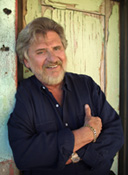 |
→ May 2004 Contents → David Douglas Duncan → Feature
|
Photo Nomad
The Legend Continues May 2004
|
 |
|||
|
Whenever young photographers have asked me to recommend a good book that will inspire them, I have always told them to go out and buy a copy of Yankee Nomad by David Douglas Duncan. For nearly 40 years this volume, a collection of great photographs and behind-the-scenes stories, has endured as a portrait of a great photojournalist, as well as the events and people that have made up our history of the world spanning over 60 years.
What had brought me to Castellaras was the publication of his new book, a handsome 464-page volume that reprises the career he celebrated in "Yankee Nomad." Of course, in the intervening 37 years there have been other adventures, other wars, such as Vietnam, and new friends, such as the great artist, Pablo Picasso. Duncan added these stories and photographs to the new autobiography, which he calls Photo Nomad. It is a very personal book that blends photographs and text to take the reader through a remarkable life. To understand David Douglas Duncan, you have to understand that he is a U.S. Marine -- first, last, and always. He photographed American planes strafing the Okinawan jungle from a hollowed-out fuel tank slung under the belly of a P-38 during World War II. He endured the freezing cold sweeping down from Manchuria while accompanying Marines fighting in pitched battles on the hillsides of Korea, and he bunkered-in with Leathernecks as they withstood Communist assaults at the lonely outpost of Khe Sanh in Vietnam. Today, he is still proud to be a Leatherneck Lt. Colonel. Duncan has never been afraid to take risks. He also has never been afraid to speak his mind, and will throw all his personal energy and resources behind projects he believes in. All royalties and income from his war books was donated to the wives and children of Marines who never made it home. He was not afraid to challenge Henry Luce, the publisher of LIFE, the magazine for which he worked, when he foresaw that French policy in Indochina in the early 1950s was leading to what would become an American quagmire. Luce's pithy comment to Managing Editor Ed Thompson following that meeting in Rome became legend: "Duncan didn't fire me!" Fifteen years later, his predications became all too true, as he shared weeks under fire with Marines at Khe Sanh. He was so outraged by what he considered to be a callous waste of young American lives that he published his own small book of photographs of the siege, titled "I Protest!"
As Duncan claims, he is genuinely the oldest living photojournalist who has the perspective of how these events have unfolded over the years and, as a result, has strong convictions about what is now playing out in today's caldrons of violence. Duncan has always trained his lenses on the faces of human beings. Whether it is the rigid Marine on a frozen hill south of the Yalu River in North Korea -- who replies to Duncan's question, "If I were God, what would you want for Christmas?" with the answer, "Give me Tomorrow" -- or the intense gaze of artist Pablo Picasso, or the radiant beauty of actress Ava Gardner on the set of "The Barefoot Contessa," it has always been people that have fascinated him. Friendships have always played an enormous role in his life. No matter how famous he became, he never forgot for one moment that he was Dave Duncan from Kansas City. That openness and concern for all those he met is what opened countless of doors to him around the world. Although he was extremely critical of the Nixon administration in the 1970s, he remained a close friend of the President, whom he first met as a young Naval officer in the South Pacific. Long after Nixon left Washington in disgrace, Duncan continued to visit him at his San Clemente home. He has always had the curiosity of a child, which is perhaps the greatest gift that a photographer can possess. He always wanted to explore the world and its treasures, and to explain them to the countless thousands who have viewed them in his photographs. In his search to offset so much of the horror he has witnessed, he has turned to photographing the landscape surrounding his home, most notably the sunflower belt of southern France, for his book, "Sunflowers for Van Gogh." Today, Duncan is living the kind of life that most of us would wish for ourselves, with his wife of 42 years, Sheila, and his Norwich Terrier, Yo-Yo. He follows the news events in the Mideast assiduously, and bombards the International Herald Tribune and The New York Times with Letters to the Editor. He is sometimes cantankerous. Last year he picked a fight with photographic legend Henri Cartier-Bresson by publishing photographs he had made of the maestro while having ice cream and tea together in Paris. Cartier-Bresson is notorious for protecting the privacy of his image. In explanation, Duncan wrote, "Fifty years ago, he published "The Decisive Moment." It became THE sacred book for generations of candid photographers who accepted his theory that all subjects, at some fleeting instant, arrive at a point in time-expression-movement-geometrical composition which is IT. Fire! Then search for your next subject. "Except...for myself -- life is a constantly flowing river of time-expression-passion-promise-tragedy...and a vast array of elements beyond any human anticipation or sense of timing or design, no matter how deft the shutter finger or sensitive the eye. Life remains static for no one. "This is why I shoot as I do -- waiting, always waiting. For that fleeting touch of magic on the face of life itself...and it will always elude me."
© Dirck Halstead
|
||||
Back to May 2004 Contents |
|

